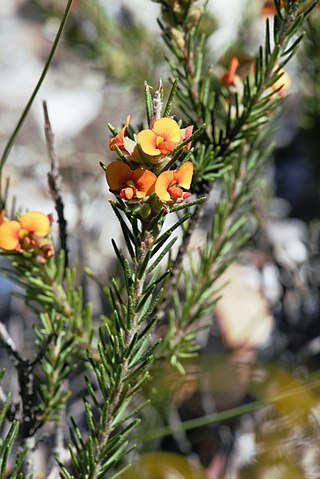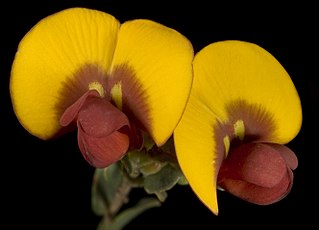
Grevillea cirsiifolia, commonly known as varied-leaf grevillea, is a species of flowering plant in the family Proteaceae and is endemic to the south-west of Western Australia. It is a prostrate shrub, usually with divided leaves with eight to thirty lobes, and creamy white and bright yellow flowers with a white to pale yellow style.
Grevillea pinifolia, commonly known as the pine-leaved grevillea, is a species of flowering plant in the family Proteaceae and is endemic to a restricted area in the south-west of Western Australia. It is a low, mounded shrub with linear, more or less cylindrical leaves and red to orange-red flowers.

Isopogon heterophyllus is a plant in the family Proteaceae and is endemic to the southwest of Western Australia. It is a shrub with simple or pinnate, cylindrical leaves and hairy, usually pink flowers.

Dillwynia brunioides, commonly known as sandstone parrot-pea, is a species of flowering plant in the family Fabaceae and is endemic to New South Wales. It is an erect shrub with silky-hairy stems, linear, grooved leaves and yellow flowers with red markings.
Dillwynia dillwynioides is a species of flowering plant in the family Fabaceae and is endemic to the south-west of Western Australia. It is a low-lying or erect, spindly shrub with cylindrical, grooved leaves and yellow, red or orange flowers with yellow, red or orange markings.
Pultenaea aspalathoides is a species of flowering plant in the family Fabaceae and is endemic to the south of Western Australia. It is an erect, spindly shrub with hairy, needle-shaped leaves and yellow flowers.

Pultenaea ochreata is a species of flowering plant in the family Fabaceae and is endemic to the south-west of Western Australia. It is an erect shrub with egg-shaped leaves with the narrower end towards the base and yellow-orange flowers with red or brown marks.
Pultenaea pinifolia is a species of flowering plant in the family Fabaceae and is endemic to the south-west of Western Australia. It is an erect, slender shrub with pine-like leaves and yellow-orange flowers with orange marks.

Gompholobium ovatum is a species of flowering plant in the family Fabaceae and is endemic to the south-west of Western Australia. It is an erect or prostrate shrub with egg-shaped leaves and yellow and red to purple, pea-like flowers.

Bossiaea pulchella is a species of flowering plant in the family Fabaceae and is endemic to the south-west of Western Australia. It is a slender, erect shrub with egg-shaped leaves, and orange-yellow, purplish brown and dark red flowers.

Gompholobium shuttleworthii is a species of flowering plant in the pea family Fabaceae and is endemic to the south-west of Western Australia. It is an erect shrub with pinnate leaves with five to nine leaflets, and pink or purple flowers with some darker markings.

Gompholobium villosum is a species of flowering plant in the pea family Fabaceae and is endemic to the south-west of Western Australia. It is a slender, erect shrub with simple, needle-shaped leaves with one or two grooves on the lower surface, and violet, pink or purple flowers.
Bossiaea spinescens is a species of flowering plant in the family Fabaceae and is endemic to the south-west of Western Australia. It is a slender, spreading or compact, spiny shrub with oblong to oval leaves and yellow and reddish-brown, pea-like flowers.
Pultenaea strobilifera is a species of flowering plant in the family Fabaceae and is endemic to the south-west of Western Australia. It is an open to dense, domed or spindly, erect shrub with simple leaves and yellow-orange and salmon pink to bright pink flowers.
Gompholobium viscidulum is a species of flowering plant in the pea family Fabaceae and is endemic to the south-west of Western Australia. It is an erect shrub with pinnate leaves with five to seven leaflets, and yellow flowers.

Kennedia microphylla is a species of flowering plant in the family Fabaceae and is endemic to the south-west of Western Australia. It is a prostrate, mat-forming creeper with relatively small, trifoliate leaves and red flowers.
Daviesia benthamii is a species of flowering plant in the family Fabaceae and is endemic to the west of Western Australia. It is an erect, bushy shrub with scattered, cylindrical, sharply pointed phyllodes, and yellow-orange and reddish-brown flowers.

Daviesia brachyphylla is a species of flowering plant in the family Fabaceae and is endemic to the south-west of Western Australia. It is a spreading to bushy shrub with cylindrical phyllodes with a slightly downcurved point and orange, maroon and red flowers.

Mirbelia ovata is a species of flowering plant in the family Fabaceae and is endemic to the south-west of Western Australia. It is a spreading or prostrate shrub that typically grows to a height of 15–60 cm (5.9–23.6 in) and many branches, covered with woolly or shaggy hairs. Its leaves are egg-shaped, less than 12 mm (0.47 in) long and sharply-pointed. The flowers are arranged in pairs or threes at the base of branches and are yellow or orange and purple and appear from August to October. It was first formally described in 1844 by Carl Meissner in Lehmann's Plantae Preissianae. The specific epithet (ovata) means "wider below the middle".

Pimelea tinctoria is a species of flowering plant in the family Thymelaeaceae and is endemic to the south-west of Western Australia. It is an erect, spindly shrub with elliptic leaves arranged in opposite pairs, and compact heads of many yellow or yellowish-green flowers usually surrounded by 4 to 7 pairs of egg-shaped to narrowly elliptic yellow and green involucral bracts.












